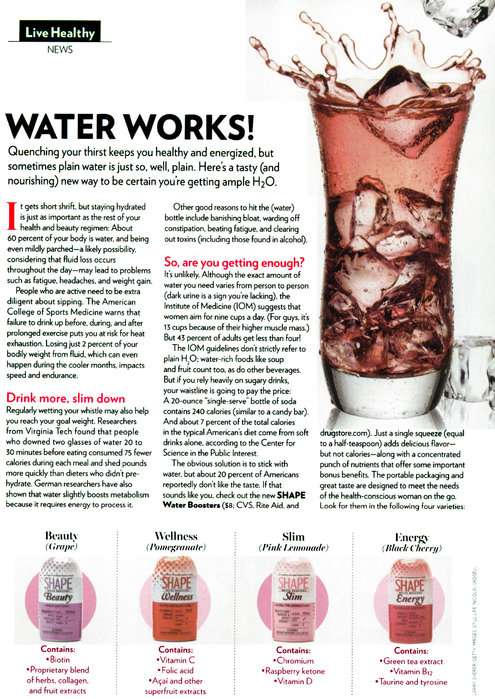The Reading Room at the Global Worldwide Headquarters of Sneak Adtack is starting to fill up, so the hardtracking staff is offloading these ads ‘n’ ends.
Start with this piece from the New York Times:
Promoting Its Own Products, a Magazine Labels an Ad as News
CONTENT from advertisers that resembles editorial coverage, commonly called native advertising, is drawing heightened scrutiny from the Federal Trade Commission, which wants to establish guidelines for labeling it clearly. Now Shape magazine has drawn a rebuke for such content from advertising regulators for an unusual case in which it served as both publisher and advertiser.
In the September issue of Shape, a full-page article carried the headline “Water works!” under the heading of “News.” After citing many studies espousing hydration, and a warning from the Center for Science in the Public Interest against high-calorie sugary drinks, the non-bylined article said that about 20 percent of Americans did not like the taste of water.
“If that sounds like you, check out the new Shape Water Boosters,” the article reads . . .
According to the Times piece, “[t]he National Advertising Division, the investigative arm of the ad industry’s voluntary self-regulation system, which operates under the aegis of the Better Business Bureau, conducted [an] inquiry. Shape ‘blurred the line between advertising and editorial content in a way which could confuse consumers,’ the division stated in a ruling released last week.”
Ya think?
So we can all agree that the default mode of native advertising is deception, as MediaPost notes.
Native Advertising: The Marketing Trend That Dare Not Speak Its Name (Unless Required)
This will be the year of native advertising, in all forms of the Internet, but probably very successfully in the online video portion of the Web.
It’s got people fretting and it should, because it’s sometimes hard to distinguish untouched content from content that has been put there by a marketer. Much of the native content is pretty good stuff, in fact, and it seems there’s not any objection to it, as long as the marketer ‘fesses up, or makes it look very obvious that it’s not normal editorial content.
Which is the problem . . .
Ya think?
Finally, there’s this native advertising primer from The Awl.
No, BuzzFeed Did Not Invent Native Advertising
News curmudgeons relish blaming the internet for things they don’t like, a pastime that is maddening, a little sad, and just ironic. These people who fetishize print
media’s past are often selective in their memories of it.
For instance, BuzzFeed didn’t invent coverage of silly animals, and it certainly didn’t invent native advertising—that is, advertising with a narrative structure that mirrors surrounding editorial content. (You might also call this “sponsored content” or “advertorial.”)
Much of the recent media chatter about native ads makes it sound as though sponsored content was just invented. But what we now call native advertising has deep roots in print journalism—as do aggregation, curation, and opinion-infused reporting.
Makes ya think, yeah? The piece is well worth the read, although reporter Adrienne LaFrance can be a little overbroad in her definition of native advertising. But with the new wave of ads in sheep’s clothing, you can’t be too critical.
John R. Carroll is media analyst for NPR's Here & Now and senior news analyst for WBUR in Boston. He also writes at Campaign Outsider and It's Good to Live in a Two-Daily Town.
John R. Carroll has 305 post(s) on Sneak Adtack

1 comment
The Sneak in Review: Native (Advertising) Intelligence | Campaign Outsider says:
Jan 18, 2014
[…] the rest at Sneak Adtack. Share this:ShareLike this:Like […]